Kunstmuseum Basel
The Kunstmuseum Basel houses the largest and most significant public art collection in Switzerland, and is listed as a heritage site of national significance.[1]
 The main building from 1931 | |
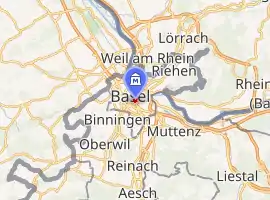
| |
| Established | 1661; 359 years ago |
|---|---|
| Location | Basel, Switzerland |
| Type | Art museum |
| Director | Josef Helfenstein |
| Website | www.kunstmuseumbasel.ch |
Its lineage extends back to the Amerbach Cabinet, a collection of works by Hans Holbein purchased by the city of Basel and the University of Basel in 1661, which made it the first municipally owned and therefore open to the public museum in the world. Its collection is distinguished by an impressively wide historic span, from the early 15th century up to the immediate present. Its various areas of emphasis give it international standing as one of the most significant museums of its kind. These encompass: paintings and drawings by artists active in the Upper Rhine region between 1400 and 1600, and on the art of the 19th to 21st centuries.
Collection
The Kunstmuseum possesses the largest collection of works by the Holbein family. Further examples of Renaissance art include important pieces by such masters as Konrad Witz, Hans Baldung (called Grien), Martin Schongauer, Lucas Cranach the Elder and Mathias Grünewald. The main features of the 17th and 18th centuries are the Flemish and Dutch schools (e.g. Peter Paul Rubens, Rembrandt, Jan Brueghel the Elder), German and Dutch still life painting. Key works from the 19th century include the Impressionists represented by Édouard Manet, Edmond Jean de Pury, Claude Monet, Paul Gauguin, Paul Cézanne as well as the paintings by Vincent van Gogh and Switzerland's Arnold Böcklin and Ferdinand Hodler. In the 20th century, the focus is on works of Cubism with Picasso, Braque and Juan Gris. Expressionism is represented by such figures as Edvard Munch, Franz Marc, Oskar Kokoschka and Emil Nolde. The collection also includes works from Constructivism, Dadaism and Surrealism and American art since 1950. Further highlights are the unique compilations of works from Pablo Picasso, Fernand Léger, Paul Klee, Alberto Giacometti and Marc Chagall.
In the realm of more recent and contemporary art, the collection maintains substantial bodies of work by Swiss, German, Italian, and American artists, including Joseph Beuys, Andy Warhol, Jasper Johns, Georg Baselitz, A.R. Penck, Brice Marden, Bruce Nauman, Jonathan Borofsky, Roni Horn, Francesco Clemente, Mimmo Paladino, Enzo Cucchi, Martin Disler, Leiko Ikemura, Markus Raetz, Rosemarie Trockel and Robert Gober.
In the year of 1939 a large body of work by German-Jewish artists, whose paintings were considered to be degenerate art by the Nazi-Regime in Germany could be saved by the Kunstmuseum, were brought to Switzerland and are on display in the museum up to this day.
In 1967 the sale of the Pablo Picasso paintings Les deux frères (1906) and Arlequin assis (1923), which had been on loan for many years at the museum, was threatened. In a referendum the people of Basel approved a state loan of 6 million Swiss francs, and the citizens also collected 2.4 million francs to purchase the two paintings for the Kunstmuseum. Pablo Picasso was so moved by this that he donated four more works to the city: Homme, femme et enfant (1906), a sketch for Les Demoiselles d'Avignon (1907) and the two major late works Vénus et l'amour and Le couple (both from 1967), which the then museum director, Franz Meyer, was allowed to select himself in Pablo Picasso's studio. Finally, Maja Sacher-Stehlin supplemented this donation with the cubist work Le poète (1912).[2]
Buildings
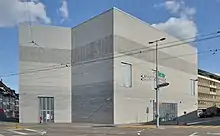
The Kunstmuseum's main building was designed and constructed 1931-1936 by architects Paul Bonatz and Rudolf Christ, adjacent to the former building of the Swiss National Bank in Basel.
In 2008, the museum acquired land on the other side of Dufourstrasse and an architectural competition was held. With international star competitors, such as five Pritzker Prize laureates (Peter Zumthor, Zaha Hadid, Rafael Moneo, Tadao Ando and Jean Nouvel) — all pitching, eventually a young local firm, Christ & Gantenbein, won the project.[3][4] The final design is an angled building, faced with concrete bricks, and at the same height as the original museum.[5][6]
Building work for the $112 million project began in 2013 and was inaugurated in April 2016. The project was funded by the Canton of Basel-Stadt and the Laurenz Foundation (Laurenz-Stiftung), established by Maja Oeri.
The extension adds 2,750 square meters of galleries, to a total of nearly 10,000 square meters.[7] The original museum now houses art from the 15th century to 1950, with later works in the extension. The upper floor of the new building houses temporary exhibitions and the middle floor and part of the ground floor the permanent collection.[4][8]
Visitors
In 2013, the Kunstmuseum had 238,000 visitors.[4]
Gallery
_-_Portrait_of_Bonifacius_Amerbach.jpg.webp) Hans Holbein the Younger, Portrait of Bonifacius Amerbach (1519)
Hans Holbein the Younger, Portrait of Bonifacius Amerbach (1519)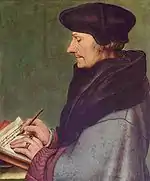 Hans Holbein the Younger, Portrait of Erasmus of Rotterdam (1523)
Hans Holbein the Younger, Portrait of Erasmus of Rotterdam (1523)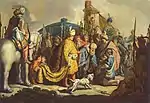 Rembrandt, David with the head of Goliath before Saul (1627)
Rembrandt, David with the head of Goliath before Saul (1627).jpg.webp) Arnold Böcklin, Isle of the Dead (1880)
Arnold Böcklin, Isle of the Dead (1880) Claude Monet, Fécamp (Calm Weather) (1881)
Claude Monet, Fécamp (Calm Weather) (1881) Vincent van Gogh, Marguerite Gachet at the Piano (1890)
Vincent van Gogh, Marguerite Gachet at the Piano (1890)%252C_oil_on_canvas%252C_73.2_x_91.5_cm%252C_Kunstmuseum_Basel.jpg.webp) Paul Gauguin, Ta matete (The market) (1892)
Paul Gauguin, Ta matete (The market) (1892)%252C_oil_on_canvas%252C_141.4_x_97.1_cm%252C_Kunstmuseum_Basel.jpg.webp) Pablo Picasso, Les deux frères (The two brothers) (1905-06)
Pablo Picasso, Les deux frères (The two brothers) (1905-06)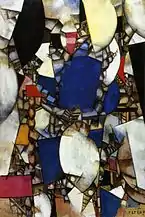 Fernand Léger, Femme en Bleu (Woman in Blue) (1912)
Fernand Léger, Femme en Bleu (Woman in Blue) (1912)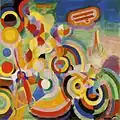 Robert Delaunay, Hommage à Blériot (1914)
Robert Delaunay, Hommage à Blériot (1914) Paul Cézanne, Le Cabanon de Jourdan (1916)
Paul Cézanne, Le Cabanon de Jourdan (1916)%252C_oil_on_canvas%252C_92_x_60_cm%252C_Kunstmuseum_Basel.jpg.webp) Juan Gris, La femme à la mandoline (Woman with Mandolin) (1916)
Juan Gris, La femme à la mandoline (Woman with Mandolin) (1916)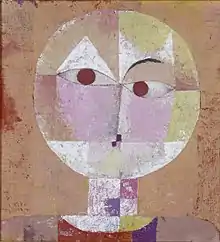 Paul Klee, Senecio (1922)
Paul Klee, Senecio (1922) Theo van Doesburg, Composition (1923-1924)
Theo van Doesburg, Composition (1923-1924)
See also
- List of paintings in collection
- Raoul Albert La Roche, Swiss art collector and donator
- Louise Bachofen-Burckhardt, Swiss art collector and donator
References
- Swiss inventory of cultural property of national and regional significance (1995), p. 53.
- https://kunstmuseumbasel.ch/en/exhibitions/2013/the-picassos-are-here!
- Cilento, Karen (21 December 2009). Kunstmuseum Extension / Christ & Gantenbein (competition project design), ArchDaily.
- Bailey, Martin (20 June 2014). A tale of two extensions The Art Newspaper.
- Kunstmuseum Basel / Christ & Gantenbein (See the project in full here), ArchDaily, 21 April 2016
- Patrick Lynch, At Kunstmuseum Basel, iart Creates a Frieze with a Technological Twist, ArchDaily, 13 May 2016
- Basel's Kunstmuseum - New and Improved, Basel Life, April 2016
- Herzog, Andres (15 April 2016). "Basler Symphonie in Grau" [Basel Symphony in Gray]. Tages-Anzeiger (in German). Retrieved 15 June 2020.
External links
| Wikimedia Commons has media related to Kunstmuseum Basel. |